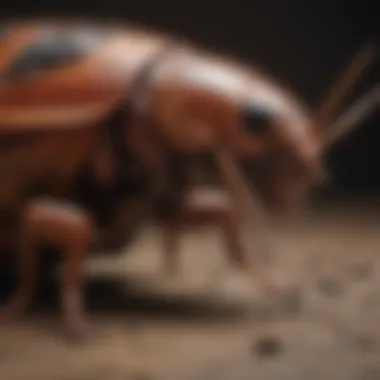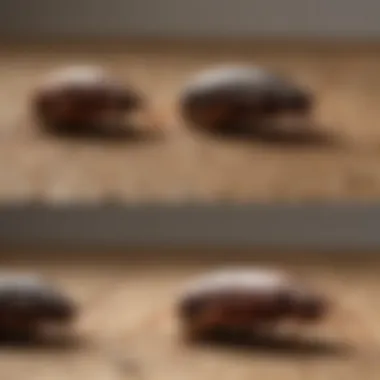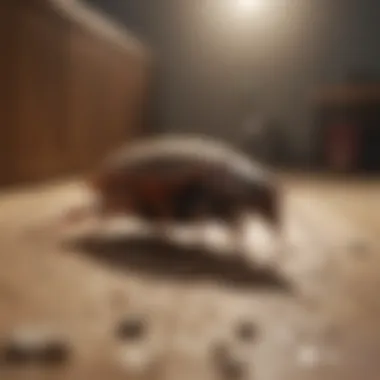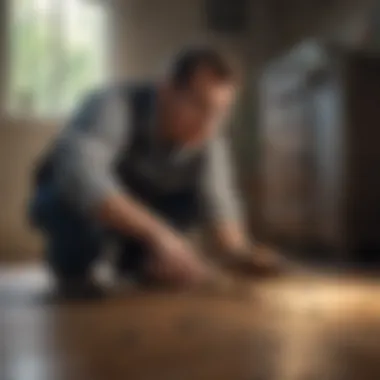Effectiveness of Roach Extermination Methods


Intro
Roaches are more than a mere nuisance; they embody a serious threat to hygiene and health. These pests thrive in various environments, making them a relentless challenge for homeowners. The concern extends beyond their presence; roaches can contaminate food and trigger allergies. Understanding their biology and behavior is crucial in developing effective extermination strategies. This article will provide insights into an array of roach extermination methods, comparing traditional chemical solutions with modern eco-friendly alternatives. It will also examine best practices for both homeowners and pest management professionals to achieve sustainable results.
Understanding Pests
Definition of Pests
Pests, in general terms, are organisms that can cause damage to crops, structures, and even human health. They create imbalances in ecosystems and can frustrate day-to-day activities when they invade households. Roaches, specifically, belong to the order Blattodea. Their ability to reproduce rapidly and adapt to various environments promotes their persistence in urban settings.
Importance of Pest Identification
Identifying the species of roach is pivotal to effective extermination. Different species often require tailored approaches for treatment. American cockroaches, German cockroaches, and Oriental cockroaches exhibit distinct behaviors and vulnerabilities. For instance, German cockroaches tend to dwell indoors and reproduce quickly, which often necessitates a specific focus on removing their breeding sites. Accurate identification helps in selecting an appropriate extermination method, be it chemical, mechanical, or biological.
Prevention Techniques
Home and Garden Preventative Measures
Effective pest management begins with preventive practices both indoors and outdoors. Keeping living spaces clean is fundamental. Addressing food storage, cleanliness, and moisture can deter roaches from entering your home:
- Seal Entry Points: Examine your home for cracks and crevices. Seal them to block roach entry.
- Food Storage: Store food in airtight containers to limit accessibility for pests.
- Regular Cleaning: Vacuum and wipe down surfaces, especially in kitchens, to eliminate food particles.
These steps can significantly reduce the likelihood of an infestation.
Seasonal Prevention Tips
Roaches are more active in warmer months. Adjusting your prevention tactics according to the season can enhance your efforts:
- Spring Check-Up: Once winter fades, inspect your property for signs of roaches and seal entry points.
- Moisture Control in Summer: Address standing water and leaks, as these provide ideal nesting sites.
- Fall Preparation: Before cold weather, clear debris from yards, as roaches may seek warmth in your home.
Eco-Friendly Pest Control Solutions
Overview of Sustainable Practices
As the demand for sustainability rises, many seek eco-friendly alternatives for roach extermination. These practices reduce chemical exposure while being effective against roaches. Integrated Pest Management (IPM) emphasizes prevention, monitoring, and control, minimizing reliance on chemical solutions.
Natural Remedies and Their Effectiveness
Several natural methods show promise in controlling roaches, although their effectiveness may vary:
- Boric Acid: This powder can be effective when used correctly, but caution is important to avoid exposure to children or pets.
- Diatomaceous Earth: This non-toxic powder works by dehydrating pests upon contact.
- Essential Oils: Oils like peppermint and tea tree may deter roaches, but their application often needs to be consistent and systematic.
While natural remedies present a lower risk to health and environment, thorough application is essential for effectiveness. Further research may be necessary to evaluate the best approaches for your circumstances.
Prelims to Roach Extermination
Roach extermination is a crucial component in maintaining a healthy living environment. The presence of roaches can signify underlying issues within a home, such as moisture problems or poor sanitation. The elimination of these pests is not just about aesthetics; it relates to health, comfort, and overall quality of life. Effective extermination reduces the risk of disease transmission. It also helps avoid emotional distress for those who feel uneasy in roach-infested spaces.
In this article, we will delve into the various methods of roach extermination. Understanding these methods allows homeowners to make informed choices. Both traditional and modern techniques will be analyzed. The effectiveness, sustainability, and practicality of each method will be discussed. Ultimately, this examination aims to equip homeowners with knowledge vital for effective pest management.


Understanding the Importance of Extermination
Extermination is important due to the health risks that roaches pose. Roaches can carry bacteria and allergens, leading to respiratory issues and other health concerns. They thrive in unsanitary environments and reproduce quickly. Therefore, timely intervention is critical. The longer roaches remain, the more difficult they are to control.
Additionally, acknowledging the necessity of extermination can foster a proactive approach. Regular inspections and preventive measures can help keep homes free from roaches. Homeowners should view extermination as part of comprehensive pest management, which includes sanitation and environmental modifications.
Overview of Common Roach Species
Several species of roaches infiltrate homes, the most notorious being the German cockroach, the American cockroach, and the Oriental cockroach. Each species has unique habits and habitats.
- German Cockroach: This species is small, brownish, and known for its rapid reproduction. It often resides in kitchens and bathrooms.
- American Cockroach: Larger than the German variant, American roaches prefer warm areas; they can be found in basements or sewers.
- Oriental Cockroach: Dark and shiny, these roaches thrive in cool, damp environments and can often be found in basements or around drains.
Understanding these species helps in pinpointing the most effective extermination strategy. Each requires different methods based on its breeding habits and preferred environments.
Biological Impact of Roaches
Roaches have a significant biological impact that extends beyond their nuisance status in households. Understanding this impact is vital for effective roach extermination. Roaches are resilient creatures that adapt well to various environments. They thrive in urban settings, where they exploit available resources, such as food, water, and shelter. This adaptability makes them challenging to control.
One crucial aspect of the biological impact of roaches is their role as vectors of disease. They are known to carry pathogens that can lead to health issues in humans. These include bacteria, viruses, and allergens. Health risks associated with roaches highlight the importance of timely extermination.
Furthermore, roaches can contribute to allergic reactions. The presence of roach droppings and shed skins can aggravate asthma and allergies, particularly in sensitive individuals. Thus, addressing the biological impact of roaches is not just about extermination; it is about safeguarding public health.
Health Risks Associated with Roaches
Roaches are infamous for their ability to transmit various diseases. They roam through unsanitary areas, carrying harmful bacteria like Salmonella and E. coli on their bodies. When they come into contact with food surfaces, they can contaminate food, leading to potential outbreaks of gastrointestinal illnesses.
In addition to bacterial infections, roach droppings and saliva contain allergens that can trigger asthma and allergic reactions in vulnerable populations, especially in children. According to the Centers for Disease Control and Prevention (CDC), exposures to these allergens can lead to chronic health conditions.
"Roaches can exacerbate asthma, particularly in children. Their droppings and body parts are known triggers for allergic reactions."
The Ecological Role of Roaches
Despite their negative reputation, roaches serve essential ecological functions. They are scavengers, playing a vital role in the decomposition process. By consuming decaying organic matter, they help recycle nutrients back into the soil. This activity is crucial for maintaining ecosystem balance.
Furthermore, roaches serve as food for a variety of predators, including birds and small mammals. Their presence in the food chain contributes to the biodiversity of the surrounding environment. Although they are often seen as pests, recognizing their ecological role emphasizes the need for balanced pest management strategies.
In summary, the biological impact of roaches encompasses both health concerns and their ecological roles. While extermination is necessary, it should be approached with an understanding of these complexities.
Assessment of Extermination Methods
Effective roach extermination requires a critical evaluation of various methods available today. Understanding the strengths and weaknesses of each extermination technique helps homeowners make informed decisions about how to manage infestations. The process of assessing these methods involves considering various elements, such as effectiveness, safety, cost, and environmental impact.
Choosing the right extermination strategy can greatly affect the long-term management of roach populations. Some methods may provide immediate results, while others focus on preventing future infestations. It is important to recognize that no single solution will fit every situation. Each household has its unique circumstances that will determine the most appropriate approach.
Chemical Extermination Techniques
Chemical extermination methods remain the most common choice for tackling roach problems. These techniques often involve the use of pesticides that target the insects directly. They can be extremely effective due to their fast action and ability to cover large areas. However, they come with concerns, particularly regarding human health and environmental safety.
Homeowners should carefully follow the instructions provided by manufacturers and consider consulting a professional when using these products. Regular application might be necessary to ensure prolonged effectiveness.
Boric Acid and Its Effectiveness


Boric acid is one of the widely used substances in pest control due to its relative safety and proven efficacy. When roaches consume boric acid, it disrupts their digestive system and ultimately leads to death. This method is particularly appealing as it poses less risk to humans and pets compared to traditional chemicals.
To achieve the best results with boric acid, it is essential to apply it strategically in areas where roaches are likely to forage. Homeowners should remain patient, as it might take some time for the roaches to consume the bait and die.
Insect Growth Regulators (IGRs)
Insect growth regulators provide a unique approach to pest control. IGRs do not kill adult roaches directly but rather inhibit their growth and reproduction. This leads to a gradual decline in the population over time.
Many homeowners appreciate IGRs for their long-lasting effects and reduced risk to humans and pets. When used in conjunction with other extermination methods, IGRs can significantly enhance overall efficacy.
Natural and Eco-Friendly Solutions
Increasingly, homeowners are turning to natural and eco-friendly solutions for roach management. These methods can include diatomaceous earth, essential oils, and homemade traps. Such solutions aim to minimize exposure to harmful chemicals while still effectively deterring or eliminating roaches.
Although natural methods may not always yield immediate results compared to chemical options, their long-term application can lead to successful pest management. Homeowners should research and experiment with various natural solutions to find the best fit for their unique situations.
The best extermination method varies by situation, and combining different approaches often proves most effective.
By carefully assessing the available extermination methods, homeowners are better equipped to make informed decisions that prioritize safety and long-term effectiveness.
Professional vs. DIY Extermination
The debate between professional extermination services and do-it-yourself (DIY) methods is significant in the realm of roach management. Understanding the pros and cons of each approach is essential for homeowners striving for effective solutions against these pests. This section will explore various factors that influence the choice between professional help and home-based efforts.
The Role of Pest Control Professionals
Pest control professionals bring expertise and specialized skills to effectively eliminate roaches. They utilize a combination of methods tailored to the specific infestation level. Professionals often apply chemical extermination techniques that are inaccessible to the general public. Furthermore, they can identify the species of roach present, which is crucial for choosing the most effective treatment.
One major advantage of hiring professionals is their ability to conduct thorough inspections, locating potential breeding sites. This knowledge can be invaluable in not only treating current infestations but also preventing future occurrences. Moreover, they typically offer warranties or follow-up services, ensuring that roaches are handled over the long term.
Effectiveness of DIY Methods
DIY methods have become popular among homeowners, primarily due to their perceived cost-effectiveness. Many individuals attempt to manage infestations using readily available products or homemade remedies. Common DIY solutions include boric acid, traps, and even natural repellents.
The effectiveness of these methods varies significantly, depending on several factors:
- Severity of Infestation: Minor infestations can sometimes be managed with DIY strategies, while larger populations often require professional intervention.
- Knowledge and Skills of the Homeowner: A clear understanding of pest behavior and effective treatment protocols can enhance DIY success rates.
- Product Quality: Not all products on the market are equally effective. Homeowners must research to find reliable options.
However, it is important to note that while DIY methods can be effective, they often lack the comprehensiveness that professional services provide. If the root cause of the infestation is not addressed, DIY efforts may only serve as a temporary fix, leaving room for recurrence.
Cost Analysis of Professional Services
When considering extermination options, cost is a critical factor. Professional services typically involve higher initial expenses compared to DIY methods. However, the cost-benefit analysis reveals that investing in professional help may save homeowners money in the long run.
Some costs associated with professional services may include:
- Inspection Fees: Initial evaluations can range significantly based on location and infestation extent.
- Treatment Costs: Commonly, the cost for treatments varies by method used and effectiveness guaranteed.
- Follow-Up Services: These are essential in ensuring the extermination is successful and provide additional protection.
DIY methods can be tempting due to lower upfront costs but often result in repeated expenses if the infestation returns. Sometimes cheap solutions lead to more significant problems later, which may ultimately cost more than a one-time professional service.


Limitations of Roach Extermination
Understanding the limitations of roach extermination is vital for homeowners and pest management professionals. Despite the availability of various extermination methods, none guarantee complete eradication of roach populations. Recognizing these limitations allows for better management decisions. It is necessary to combine extermination tactics with preventive measures to create an effective long-term strategy.
Resistance Development in Roaches
Roaches have a remarkable ability to develop resistance to extermination methods. This resistance often relates to the overuse of specific chemical treatments. As roaches encounter these substances repeatedly, those that survive tend to pass on resistant genes to their offspring. This results in populations that are increasingly difficult to control.
For example, a common active ingredient used in pesticides is pyrethroids. Over time, roaches can develop mechanisms that allow them to detoxify these substances. This leads to a need for more potent chemicals, which can raise health and environmental concerns. Thus, the effectiveness of roach extermination diminishes over time.
To mitigate resistance, homeowners should vary their approaches and incorporate non-chemical methods. Using traps, monitoring, and clean-up can help lower the population without solely relying on pesticides.
Challenges in Long-Term Control
Long-term control of roach infestations presents several challenges.
- Habitat Resilience: Roaches are highly adaptable creatures. They can thrive in a range of environments, from kitchens to basements. Identifying and eliminating hiding spots is crucial, yet it is often overlooked.
- Food and Water Sources: Roaches need food and water to survive. If a property provides these resources, extermination efforts may fail. Regular sanitation practices must be integrated alongside any extermination strategy.
- Reinfestation Risks: Even after successful extermination, the risk of reinfestation remains high. New roaches can easily re-enter a clean environment from adjacent units, cracks, and crevices.
Homeowners should be proactive. Implementing continuous monitoring and maintenance practices is crucial. Regular inspections and sanitation can significantly reduce the likelihood of new infestations. By understanding these limitations, better pest management strategies can be employed.
Best Practices for Roach Prevention
Roach prevention is crucial for maintaining a healthy and pest-free environment at home. It is often more efficient to prevent roach infestations than to deal with the aftermath of an outbreak. Effective prevention strategies not only reduce the risk of roaches entering the home but also create an uninviting atmosphere that discourages their presence. Here, we will outline two key aspects of prevention: sanitation measures and eliminating habitat and food sources.
Sanitation Measures
Sanitation plays a pivotal role in roach prevention. Roaches are attracted to food and moisture. Therefore, ensuring that the home is clean and dry can significantly minimize their chances of survival. Here are some specific sanitation measures:
- Regular Cleaning: Frequent vacuuming and mopping can remove crumbs and spills that might attract roaches.
- Proper Food Storage: Store food in airtight containers. This not only prevents leaks but also makes it harder for roaches to access the food.
- Dishwashing: Do not leave dirty dishes in the sink overnight. Clean them promptly after use.
- Trash Management: Dispose of garbage daily. Use bins with tight-fitting lids to deter roaches from scavenging.
- Moisture Control: Fix leaky pipes and eliminate standing water in kitchen and bathroom areas.
By maintaining a clean environment, homeowners can drastically lessn the likelihood of encountering roaches.
Eliminating Habitat and Food Sources
In addition to sanitation, removing potential habitats and food sources is vital. Roaches prefer dark, secluded areas where they can hide. They also seek out places with easy access to food and water. To tackle this:
- Seal Entry Points: Inspect the home for cracks and gaps around doors, windows, and walls. Use caulk or other sealants to close off these entry points.
- Declutter: Reducing clutter can eliminate the hiding spots roaches favor. Keep storage areas organized, and avoid stacking boxes against walls.
- Landscape Management: Trim vegetation around the home. Bushes and tree branches can provide roaches direct access to the home.
- Regular Inspection: Periodically check your property for signs of roaches, such as droppings or egg cases. Early detection can prevent larger issues later.
By implementing robust sanitation measures and actively working to eliminate habitats and food sources, homeowners can create an inhospitable environment for roaches. These preventative steps are essential for long-term pest management, ensuring that your home remains roach-free.
Epilogue
The examination of roach extermination methods highlights its significance to maintaining a healthy living environment. As roaches pose considerable health risks, understanding their management is essential for homeowners. This final section emphasizes critical insights gained from the previous analyses.
The Future of Roach Management
As we look forward, the future of roach management is increasingly leaning towards integrated pest management (IPM) strategies. This method combines various control techniques, emphasizing sustainability and low environmental impact. Emerging technologies, such as smart traps and monitoring systems, are likely to play a pivotal role. These innovations will allow for real-time data collection, which enables a more targeted approach in extermination efforts. Additionally, an ongoing focus on reducing chemical inputs and reliance on natural deterrents aligns well with society’s growing preference for eco-friendly solutions.
Final Recommendations for Homeowners
Homeowners can enhance their roach management efforts by adopting a proactive approach. Here are several key recommendations:
- Regular inspections: Regular checks for signs of roach activity can prevent larger infestations.
- Utilize proper sanitation: Ensuring kitchens and dining areas are clean will minimize food sources for roaches.
- Seal entry points: Close any gaps or cracks in windows and doors to limit roach access.
- Consider professional help: In severe cases, engaging pest control professionals may offer the best chance for effective eradication.
- Stay informed: Keeping up with the latest pest management research is crucial for effective strategies.
"Proactive measures are always more impactful than reactive solutions."
By implementing these recommendations and remaining educated on pest control methods, homeowners can foster a healthier environment.



